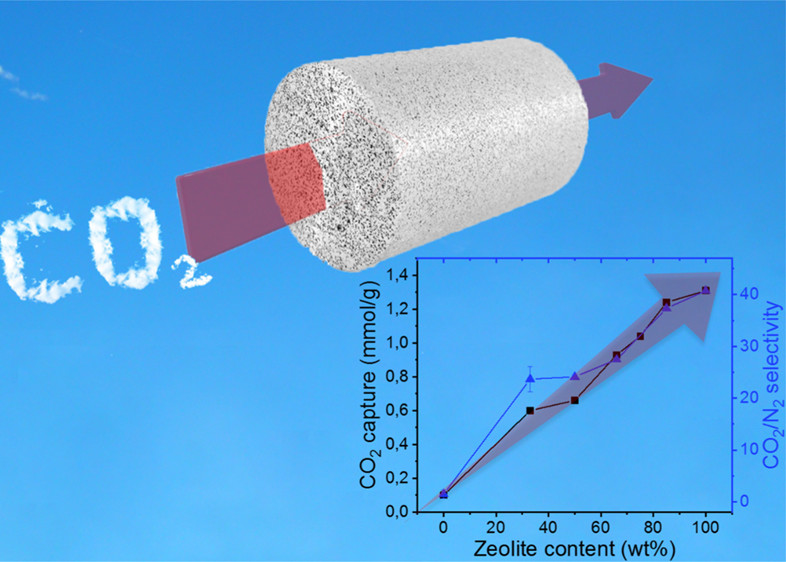The need to abate the increasing concentration of CO2 in the atmosphere requires the development of new inexpensive and highly selective technologies to reduce emissions. Zeolites is one of the materials proposed in recent years.
Luis Valencia,,† Walter Rosas,‡ Andrea Aguilar-Sanchez,† Aji P. Mathew,† and Anders E.C. Palmqvist,‡
ABSTRACT: Microporous (<2 nm) crystalline aluminosilicates in the form of zeolites offer a great potential as efficient adsorbents for atmospheric CO2 in the eminent battle against global warming and climate change. The processability of conventional zeolite powders is, however, poor, which limits their implementation in many applications, such as in gas filtration industrial systems.
In this work, we overcome this issue through the preparation of hybrid foams using mesoporous/microporous supporting materials based on the strong network properties of gelatin/nanocellulose, which can support ultrahigh loadings of silicalite-1, used as a model sorbent nanomaterial. We achieved up to 90 wt % of zeolite content and a microporous/mesoporous/macroporous hybrid material. The application of hybrid foams for selective CO2 sorption exhibits a linear relationship between the zeolite content and CO2 adsorption capacity and high selectivity over N2, where the gelatin/nanocellulose foam efficiently supports the zeolite crystals without apparently blocking their pores.
The pressing need to abate the increasing concentration of CO2 in the atmosphere, which is strongly linked to global climate change, requires the development of new technologies to reduce CO2 emissions. These technologies must be inexpensive and highly selective to CO2. In this context, porous materials with high CO2 adsorption capacity, such as zeolites, activated carbons, and metal organic frameworks, have been proposed during the last decades.
In particular, zeolites are crystalline microporous aluminosilicates consisting of a 3D network of tetrahedral AlO4 and SiO 4 quadri-connected via oxygen bridges, resulting in a system of cavities or pores that forms channels through the material, allowing the capture of smaller molecules inside the framework. Zeolites have been widely studied in applications such as gas separation, ion exchange, and catalysis because of their superior chemical and thermal stability, as well as their great potential to separate mixtures of molecules based on preferential adsorption.
Moreover, zeolites exhibit shape-selective molecular sieving because of their narrow and adjustable microporosity. However, the key challenge for zeolites in most applications is their poor processability into structural materials because of their crystalline powdered form, which limits their implementation in many large-scale applications, such as in gas separation for industrial processes. Moreover, the employment of adhesives and inorganic binders to prepare zeolite-based materials typically leads to pore blockage and reduced gas adsorption capacity. A way to overcome these limitations is through the preparation of zeolitic hybrid foams using porous supporting materials that can uptake high quantities of zeolites while preserving their efficiency and selectivity.

Bio-based foams represent an attractive alternative as supporting materials of sorbent nanomaterials from an environmental point of view not only because of their biodegradability but also because of their low cost and extremely low densities. Foams have been widely investigated for several applications including heat-insulating materials, supercapacitors, and as superabsorbents. Moreover, recently, foams have also received increased attention for CO2 capture because of their hierarchical meso-/macro-porosity, which can enhance the diffusion of molecules and limit the pressure drop over the adsorbent, allowing for high gas flow rates.
Foams are attractive also for their ease of processing and their scalability. Hybrid aerogels of zeolites with nanocellulose have been previously reported by the deposition of zeolite particles onto the cellulosic structure, where they proved to decrease the thermal conductivity upon addition of zeolites (up to 10 wt % of nanozeolite), and their potential use as super-insulating materials. However, the preparation of bio-based freestanding foams with ultrahigh loadings of zeolite has never been reported as adsorbents for selective CO2 capture.
In this work, we take advantage of the strong network properties of gelatin/nanocellulose-based foams to support ultrahigh loadings of colloidal zeolite silicalite-1, withstanding up to 90 wt % of zeolite content, which appears to be the highest loading of adsorbent in a foam ever reported.
†Division of Materials and Environmental Chemistry, Stockholm University, Frescativä gen 8, 10691 Stockholm, Sweden
‡Department of Chemistry and Chemical Engineering, Applied Chemistry, Chalmers University of Technology, SE-41296 Gothenburg, Sweden
SEE THE FULL ARTICLE https://pubs.acs.org/doi/10.1021/acsami.9b11399
